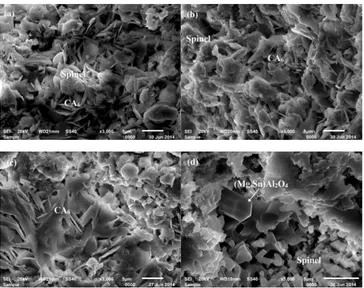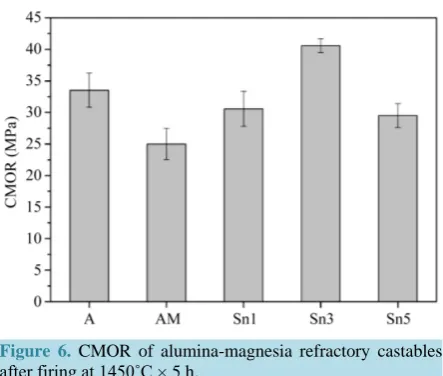http://dx.doi.org/10.4236/njgc.2015.51001
How to cite this paper: Yuan, W.J., Zhu, Q.Y., Deng, C.J. and Zhu, H.X. (2015) Effects of SnO2 Addition on the Properties of Alumina-Magnesia Refractory Castables. New Journal of Glass and Ceramics, 5, 1-7.
http://dx.doi.org/10.4236/njgc.2015.51001
Effects of SnO
2
Addition on the Properties of
Alumina-Magnesia Refractory Castables
Wenjie Yuan*, Qingyou Zhu, Chengji Deng, Hongxi ZhuThe State Key Laboratory of Refractories and Metallurgy, Wuhan University of Science and Technology, Wuhan, China
Email: *yuanwenjie@wust.edu.cn
Received 26 October 2014; revised 16 November 2014; accepted 9 December 2014
Copyright © 2015 by authors and Scientific Research Publishing Inc.
This work is licensed under the Creative Commons Attribution International License (CC BY).
http://creativecommons.org/licenses/by/4.0/
Abstract
Alumina-magnesia refractory castables have been widely used in the wall and bottom impact pad of steel ladles. The properties of alumina-magnesia refractory castables with SnO2 additive in 0 - 5 wt% range were investigated. The phase composition, microstructure, physical and mechanical properties of these refractories were studied. The results showed that the addition of SnO2 could have a great influence on the properties of alumina-magnesia refractory castables. The expansion, apparent porosity and strength of refractories with SnO2 were all more prominent than those of reference samples, which were attributed to the formation of CA6 and enhanced bonding. Mean-while SnO2 could react with spinel and CA6 to form solid solution.
Keywords
Castables, SnO2, Spinel, Calcium Hexaaluminate
1. Introduction
Alumina-magnesia refractory castables are usually bonded with calcium aluminate cement (CAC) because of its notable advantages including suitable workability and mechanical strength [1]. At high temperatures the free magnesia in the castables’ matrix could react with alumina to form spinel, meanwhile calcium dialuminate (CA2) close to 1100˚C and calcium hexaluminate (CA6) over 1400˚C formed by the reaction between CAC and alumi-na in turn [2] [3]. The formation of spinel, CA2 and CA6 is associated with the volume expansion of 8%, 13.6% and 3.01% respectively [4] [5]. Therefore, the overall expansion behavior of alumina-magnesia cement-bonded refractory castables depends on the generation of spinel and calcium aluminates. Thermal expansion behavior is one of the most important aspects for a proper refractory lining design and construction. For instance, a
con-*
bricks and unfired materials [11].
Based on the above works and considering the absence of comparative studies on different additive amounts of SnO2, the objective of this work is to evaluate the effects of different SnO2 amounts (0 - 5 wt%) on the prop-erties of alumina-magnesia refractory castables.
2. Experimental Procedure
Alumina-magnesia castables were prepared according to the Alfred packing model (q = 0.26). The compositions (Table 1) comprised tabular aluminas (T60, Almatis) as aggregates, reactive alumina (CL370, Almatis), cal-cined magnesia (95 wt%) as the main matrix components and calcium aluminate cement as the binder source (Secar 71, Kerneos). Additionally, silica fume (951U, Elkem) was added to all samples. SnO2 was used as the mineraizing additive. The dispersion was carried out by using 0.2 wt% of an electrosteric dispersant (BASF, Germany). The added water content for the vibratable casting was 4.1 wt%.
After casting, all the prepared samples were cured at 25˚C for 24 h in a climatic chamber with relative humid-ity of 100%, and dried at 110˚C for 24 h. The expansion curve of the bar sample (40 mm × 40 mm × 160 mm) was measured by heated up to 1450˚C at the rate of 5˚C/min using a self-made dilatometer. The apparent poros-ity of the castables after drying, thermal expansion measurement and firing at 1450˚C for 5 h was measured us-ing the Archimedes method. Cold modulus of rupture (CMOR) for bar sample (25 mm × 25 mm × 150 mm) af-ter firing at 1450˚C for 5 h was measured by three-point bending test. The phase composition of the castables was analyzed by X-ray diffraction with CuKα radiation (XRD, Philips, X’pert Pro MPD, Netherlands). XRD results were quantitatively evaluated by the RIR method (X’pert Highscore 3.0 Plus, PANalytical, Netherlands). The microstructure and chemical composition of the different samples was observed and measured by scanning electron microscopy (SEM, JEOL JSM-6610, Japan) and energy dispersive spectrometer (EDS, Bruker QUANTAX200-30, Germany).
3. Results and Discussion
Figure 1 shows the expansion curves, the expansion value at 1450˚C (E1450) and permanent linear change (PLC)
[image:2.595.87.545.586.723.2]of alumina-magnesia castables containing different SnO2 amounts. The expansion curve with the temperature increasing could be divided into two stages: (a) the first stage corresponded to the reversible thermal expansion from raw materials mixes; (b) then the changes in the expansion behavior were attributed to the in situ spinel
Table 1. Composition of the alumina-magnesia castables.
Raw materials Content (wt%)
A AM Sn1 Sn3 Sn5
Tabular alumina (d ≤ 6 mm) 61 61 63 63 61
Tabular alumina (d ≤ 200 μm) 25 19 16 14 14
Reactive alumina (CL370) 7 7 7 7 7
Magnesia (200 mesh) - 6 6 6 6
Calcium aluminate cement (Secar 71) 6 6 6 6 6
Silica fume (951U) 1 1 1 1 1
Figure 1. Expansion curves (a), the expansion value at 1450˚C (E1450) and permanent linear change (PLC) (b) of alu-
mina-magnesia castables containing SnO2.
and calcium hexaluminate formation as a result of the reaction between magnesia, calcia and alumina; at the same time the shrinkage behavior was derived from the sintering of the castable samples. According to Figure 1(a), the expansion of all samples presented a linear increase of the expansion values as a function of the tem-perature (<1300˚C). The expansion of samples A and AM deviated from the baseline to a small extent at higher temperature (>1300˚C). But the thermal expansion curves of the samples containing SnO2 suddenly rose up to 1450˚C. Normally, permanent linear change (PLC) of refractories was measured after the reheating or cooling, which was an indication of the volume stability of the product. Compared with expansions for different condi-tions (Figure 1(b)), PLC0 (without soaking) for all samples was less than the expansion value at 1450˚C (E1450)
as the result of the shrinkage during the cooling stage. Even the reference composition without magnesia pre-sented PLC0 with negative value. The accelerated reactions with SnO2 addition were dominant, which led to the larger expansion (PLC5) after the soaking stage.
The apparent porosity results of samples (after firing at 110˚C × 24 h, 1450˚C × 0 h and 1450˚C × 5 h) are shown in Figure 2. The volume expansion accompanying spinel and CA6 formation could lead to cracks in the castables, resulting in increased porosity of castables. It was noticed that the variation for the apparent porosity was not absolutely in accordance with the expansion level at different conditions, which was related to the phase composition and microstructure.
The XRD patterns of alumina-magnesia castables after firing at 1450˚C for 0 h and 5 h are shown in Figure 3(a) and Figure 3(c). The major phases included corundum, spinel and CA6, and the minor phases included gehlenite (Ca2Al2SiO7, C2AS), CA2, unreacted SnO2 and SiO2. The bar charts (Figure 3(b) and Figure 3(d)) present the calculated phase compositions based on RIR method. For the samples after firing at 1450˚C for 0 h, CA2 only generated in the reference samples, and CA6 formed in samples containing SnO2, which indicated that SnO2 acted as a CA6 forming agent in the initial stage. According to the phase diagram of CaO-Na2O-SiO2- Al2O3 quaternary system [12], the melting point of gehlenite was less than 1200˚C, so that gehlenite could en-hance the reaction and sintering at high temperatures. Therefore, the less gehlenite and more spinel and CA6 formation resulted in the higher expansion level for the samples containing SnO2. Gehlenite and CA2 were not found in the samples after firing at 1450˚C for 5 h. The addition of 3 wt% of SnO2 could promote the spinel formation.
The addition of SnO2 had an influence on not only the spinel and CA6 formation but also their morphology.
Figure 2.Apparent porosity of the alumina-magnesia refractory castables containing SnO2 under different conditions.
Figure 3.XRD patterns and major phase composition of alumina-magnesia castables containing SnO2: (a) (b) 1450˚C × 0 h
and (c) (d) 1450˚C × 5 h.
Cold modulus of rupture values for alumina-magnesia castables after firing at 1450˚C × 5 h are shown in
[image:4.595.91.539.298.659.2]Figure 4.SEM images of alumina-magnesia castables containing SnO2 after firing at 1450˚C × 0 h:
(a) AM, (b) Sn1, (c) Sn3 and (d) Sn5.
Figure 5. SEM images of alumina-magnesia castables containing SnO2 after firing at 1450˚C × 5 h:
[image:5.595.131.495.403.691.2]Figure 6. CMOR of alumina-magnesia refractory castables after firing at 1450˚C × 5 h.
higher porosity of the samples containing SnO2 did not lead to lower CMOR due to the influence of SnO2 addi-tion, where CMOR for sample Sn3 with higher spinel content reached a maximum value. It can be deduced that the phase composition and bonding between different phases were essential factors for the strength.
4. Conclusion
Alumina-magnesia refractory castables were prepared by the interaction between tabular alumina, reactive alu-mina and calcined magnesia with calcium alualu-minate cement. SnO2 as an additive could accelerate the formation of spinel and CA6 in this system. The bonding between different phases was enhanced by the formation of spinel and CA6 solid solution containing SnO2. The addition of SnO2 resulted in higher expansion and apparent porosi-ty as well as cold modulus of rupture. The correct regulation of additives was a key issue to attain castables with desirable properties according to their application.
Acknowledgements
The authors are grateful to National Key Basic Research Program of China (973) (No. 2012CB722702), Almatis (Qingdao), Kerneos (Tianjin) and Elkem (Shanghai) Co. Ltd. for supporting this work.
References
[1] Braulio, M.A.L., Morbioli, G.G., Milanez, D.H. and Pandolfelli, V.C. (2011) Calcium Aluminate Cement Source Evaluation for Al2O3-MgO Refractory Castables. Ceramics International, 37, 215-221.
http://dx.doi.org/10.1016/j.ceramint.2010.09.027
[2] Braulio, M.A.L., Milanez, D.H., Sako, E.Y., Bittencourt, L.R.M. and Pandolfelli. V.C. (2007) Expansion Behavior of Cement-Bonded Alumina-Magnesia Refractory Castables. American Ceramic Society Bulletin, 86, 9201-9209. [3] Braulio, M.A.L., Bittencourt, L.R.M., Poirier, J. and Pandolfelli, V.C. (2008) Microsilica Effects on Cement Bonded
Alumina-Magnesia Refractory Castables. Journal of Technical Association of Refractories Japan, 28, 180-184. [4] Braulio, M.A.L., Rigaud, M., Buhr, A., Parr, C. and Pandolfelli, V.C. (2011) Spinel-Containing Alumina-Based
Re-fractory Castables. Ceramics International, 37, 1705-1724. http://dx.doi.org/10.1016/j.ceramint.2011.03.049
[5] Simonin, F., Olagnon, C., Maximilien, S., Fantozzi, G., Diaz, L.A. and Torrecillas, R. (2000) Thermomechanical Be-havior of High-Alumina Refractory Castables with Synthetic Spinel Additions. Journal of the American Ceramic So-ciety, 83, 2481-2490. http://dx.doi.org/10.1111/j.1151-2916.2000.tb01579.x
[6] Chen, S.K., Cheng, M.Y., Lin, S.J. and Ko, Y.C. (2002) Thermal Characteristics of Al2O3-MgO and Al2O3-Spinel
Castables for Steel Ladles. Ceramics International, 28, 811-817. http://dx.doi.org/10.1016/S0272-8842(02)00047-0
[7] Schacht, C.A. (2004) Refractoires Handbook. Marcel Dekker, Inc., New York.
http://dx.doi.org/10.1201/9780203026328
http://dx.doi.org/10.1111/j.1551-2916.2010.03956.x
[9] Kostic, E., Boskovic, S. and Kis, S. (1982) Influence of Fluorine Ion on the Spinel Synthesis. Journal of Materials Science Letters, 1, 507-510. http://dx.doi.org/10.1007/BF00724732
[10] Sarkar, R., Das, S.K. and Banerjee, G. (2003) Effect of Additives on the Densification of Reaction Sintered and Pre-synthesised Spinels. Ceramics International, 29, 55-59. http://dx.doi.org/10.1016/S0272-8842(02)00089-5
[11] Jedynak, L., Wojsa, J., Podworny, J. and Wala, T. (2011) Refractories from the MgO-Al2O3-SnO2 System for
Metal-lurgical Applications. Ceramic Materials, 63, 34-39.



